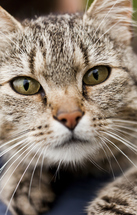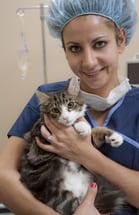Feline Diabetes
 Feline diabetes, medically known as diabetes mellitus, is a disorder in which either not enough insulin is produced by the pancreas, or the body cannot make use of the insulin properly. Because insulin helps in the metabolism of glucose, a major source of energy, diabetes is a serious condition. Feline diabetes appears to be increasing at a somewhat alarming rate. Both heredity and environment play roles in the development of diabetes which, while it can be successfully controlled with medication, is still a formidable disease that, left untreated, may be fatal.
Feline diabetes, medically known as diabetes mellitus, is a disorder in which either not enough insulin is produced by the pancreas, or the body cannot make use of the insulin properly. Because insulin helps in the metabolism of glucose, a major source of energy, diabetes is a serious condition. Feline diabetes appears to be increasing at a somewhat alarming rate. Both heredity and environment play roles in the development of diabetes which, while it can be successfully controlled with medication, is still a formidable disease that, left untreated, may be fatal.
Types of Feline Diabetes
Type 1 feline diabetes results from an insufficient production of insulin by the pancreas. Type 2 feline diabetes occurs when, although enough insulin is produced by the pancreas, the cat's body cannot use it properly. Type 3, known as transient feline diabetes, is a variety of the disease from which cats eventually recover, no longer requiring insulin.
Risk Factors for Feline Diabetes
Although it is impossible to predict whether a particular cat will develop diabetes, the following factors put animals at greater risk for the disorder:
- Being male, especially if neutered
- Being geriatric
- Being a Burmese cat
- Taking corticosteroids
- Being physically inactive
- Eating a diet high in carbohydrates
- Being obese
Certain underlying disease conditions, such as pancreatitis and hyperthyroidism are associated with the possible development of feline diabetes.
Symptoms of Feline Diabetes
When the pancreas stops producing enough insulin to digest glucose, sugar can no longer be metabolized to provide energy and is therefore excreted by the kidneys. This results in an elevated level of glucose in the urine, which in turn creates other symptoms.
Early Symptoms of Feline Diabetes
The earliest symptoms of diabetes are:
- Excessive urination
- Extreme water consumption
- Increased appetite
- Unexplained weight loss
If feline diabetes is discover at an early stage, it can usually be brought under control quickly.
Later Symptoms of Feline Diabetes
Left untreated, feline diabetes progresses until it affects all the organs of the body. Cats with advanced diabetes may exhibit some or many of the following symptoms:
- Loss of appetite
- Vomiting
- Abdominal pain
- Dehydration
- Lethargy
Cats with later stage diabetes may also, because of muscle weakness, move forward peculiarly, putting weight on their hocks instead of their toes. Unlike dogs, cats with diabetes do not typically develop cataracts.
Feline Ketoacidosis
Because diabetic cats are unable to use glucose to provide energy, their bodies begin to use fats instead. This results in the production of ketones, the by-products of fatty-acid breakdown. When high levels of ketones build up, a highly dangerous condition known as ketoacidosis develops. Ketoacidosis may cause the following symptoms:
- Breath with the odor of acetone
- Rapid, labored breathing
- Diabetic coma
Feline ketoacidosis is a life-threatening condition that requires urgent veterinary care.
Diagnosis of Feline Diabetes
 In order to diagnose feline diabetes, the veterinarian performs a complete medical examination and takes a full report of the cat's behavior and symptoms. Urinalysis and blood tests are performed to detect glucose in the blood and urine, and possibly ketones in the urine. When the urine and/or blood test positive for glucose, this is strong evidence of possible diabetes, but such tests must always be repeated because other factors, such as stress or antifreeze poisoning, may lead to false positives.
In order to diagnose feline diabetes, the veterinarian performs a complete medical examination and takes a full report of the cat's behavior and symptoms. Urinalysis and blood tests are performed to detect glucose in the blood and urine, and possibly ketones in the urine. When the urine and/or blood test positive for glucose, this is strong evidence of possible diabetes, but such tests must always be repeated because other factors, such as stress or antifreeze poisoning, may lead to false positives.
Treatment of Feline Diabetes
There is no known cure for feline diabetes, although as previously mentioned, in some cases cats' bodies seem to self-regulate over a period of time. For most cats, insulin injections are required for the remainder of their lives. Some medications for this disorder may be given orally, but injections may be easier to administer.
Dietary changes are necessary for any cat diagnosed with diabetes. Cats with this disease cannot be allowed to "graze," eating their food at will during the day, since their insulin dosages are predicated on the time they eat and the number of calories they consume. For this reason, they must be fed at consistent, regular intervals. Cats with diabetes are fed a high protein, low carbohydrate diet and their insulin injections are administered on a carefully prescribed regimen. Overweight cats must be on a restricted diet until they lose an appropriate amount of weight.
Fortunately, cats are not prone to many of the complications that affect human diabetics, such as kidney and vascular disease. Once their weight, diet and insulin levels are controlled, most diabetic cats go on to live happy, healthy lives.
